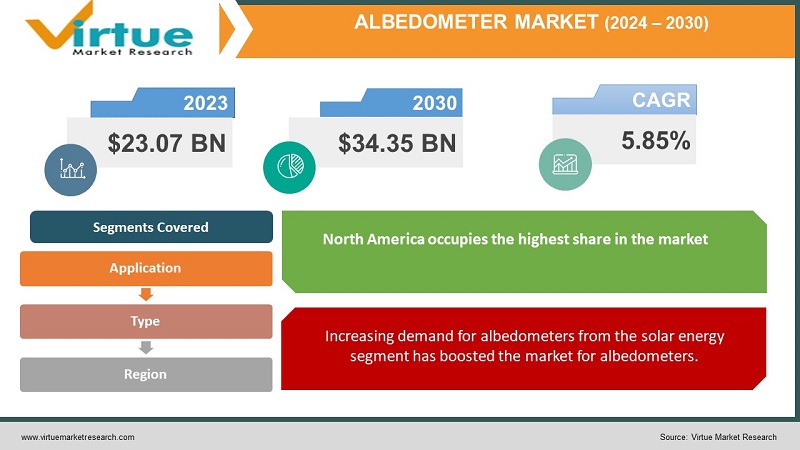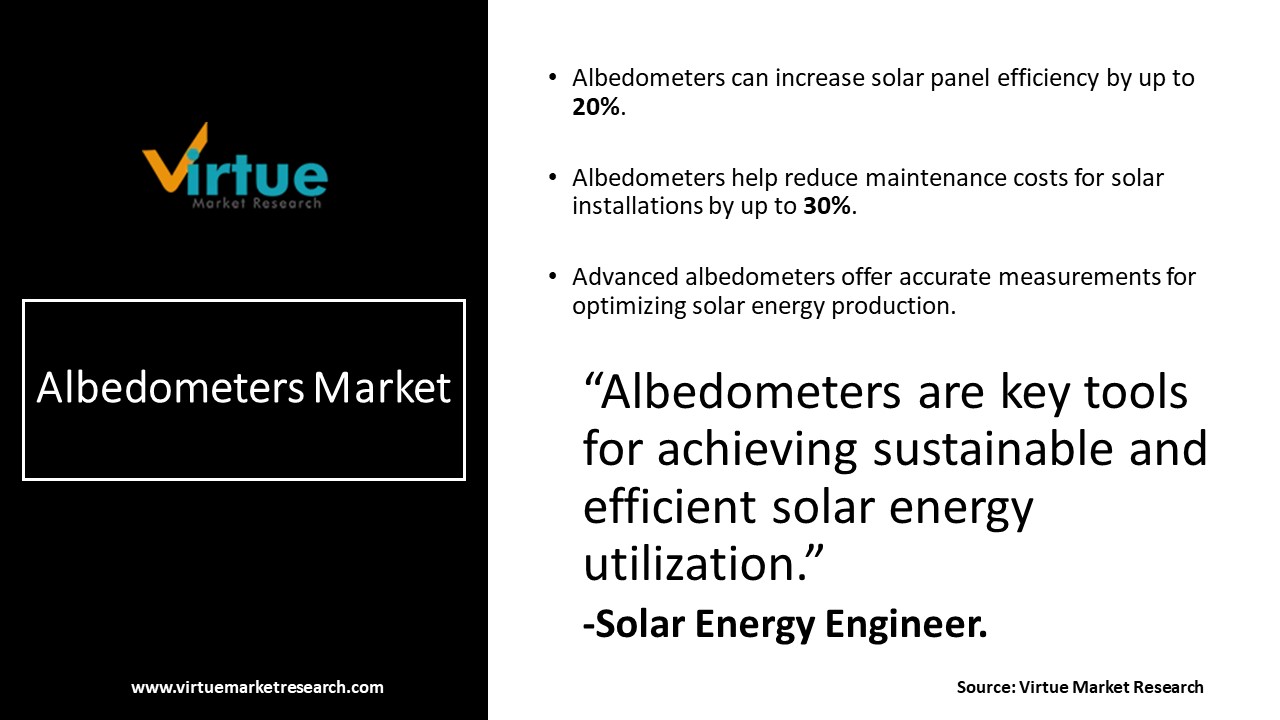Albedometer Market Size (2024-2030)
In 2023, the Global Albedometer Market was valued at $23.07 billion, and is projected to reach a market size of $34.35 billion by 2030. Over the forecast period of 2024-2030, market is projected to grow at a CAGR of 5.85%.

An albedometer is an instrument that is used to measure the radiation of a surface. It is usually used to measure the earth’s surface and has wide usage in remote sensing, that is, measuring the earth’s surface from a distance. Further, it has witnessed increased growth due to increasing demand from the solar energy sector. Often, an albedometer is made up of two pyranometers – one that faces the sky and the other one facing downwards. A pyranometer generally measures the solar radiation of a surface. The upward-facing pyranometer measures the incoming solar radiation and the downward pyranometer measures the reflected solar radiation. Moreover, there are three classes of albedometers - First Class, Second Class, and Secondary Class albedometers that measures the relation between solar radiation on the earth’s surface and reflected radiation from the ground. They are required to comply with ISO 9060 standards and guild lines that are established by the World Meteorological Organization (WMO). Furthermore, they are increasingly used in meteorology, climatology, and building physics. Moreover, the growing usage of solar PV systems has bolstered the market for albedometers.
Global Albedometer Market Drivers:
Increasing demand for albedometers from the solar energy segment has boosted the market for albedometers.
Albedometers are gaining popularity in the solar energy segment which helps to measure the albedo at PV power plants. Further, they are increasingly used to measure bifacial PV modules that generate power using solar radiation and reflected solar radiation. Further, measurement of an albedo is ideal during a sunny day as it provides an accurate measure of the power plant. Further, measuring the albedo of a solar power plant helps to optimize the placement and design of solar installations, monitor the performance of PV systems, and reduce overall material costs thereby improving energy efficiency. Moreover, frequent measuring of albedo helps customers to detect a failure in the solar PV panel beforehand and reduces future damages such as failure in generating power, breakage of panel grid, and others.
The growing usage of albedometers in agriculture has bolstered the market demand for albedometers.
Albedometers are essentially used to measure the radiation or reflectivity of a surface and henceforth it has wide applications in agriculture. Most of the developing countries rely on agriculture for their livelihood and hence making the most out of it has become crucial for farmers. Furthermore, they help in measuring the reflectivity of the ploughed field and thus provide insights on the nature and type of soil, crop sensitivity, irrigation and fertilization methods, and other such information that can increase crop yield, reduce future costs, and increase farmers’ income. Moreover, developed countries are making use of laser and sensor-based albedometers to measure crop patterns, yield growth, soil texture, and others that help them to gain higher crop yield and thus income.

Global Albedometer Market Challenges:
Higher deployment costs are the biggest challenge of the albedometer market. Since they have wide applications in solar energy, space, climate, agriculture, and others they witness increased demand from all these sectors owing to their benefits in delivering accurate information. However, albedometers are advanced measurement devices that are expensive to deploy. For instance, satellite albedometers used for remote sensing and space research cost a lot and hence it becomes difficult to deploy them. Further, developing countries are finding it difficult to deploy advanced albedometers for agricultural purposes as a result of increased costs and low income of farmers. This is because these agricultural albedometers are equipped with expensive sensors, which makes them expensive equipment to deploy in remote regions. Therefore, this can result in a decline in demand for albedometers in the market.
Global Albedometer Market Opportunities:
The Albedometer Market is anticipated to deliver lucrative opportunities for businesses, which include acquisitions, partnerships, collaborations, and agreements during the forecasted period. Furthermore, increasing demand for measuring solar PV systems, space research, and government support in the form of investment in energy-efficient technologies are predicted to develop the market for Albedometers s and enhance its future growth opportunities.
COVID-19 Impact on Global Albedometer Market:
The pandemic had a negative impact on the market for albedometers. There was a decrease in demand for albedometers as a result of a disrupted supply chain, reduced consumer income, and a shortage of production. Further, the equipment required to build and deploy an albedometer witnessed a shortage as a result of global lockdown and trade restrictions. However, remote sensing via albedometer helped researchers and scientists to understand the atmospheric changes on the Earth’s surface. These included insights into climate change, and thermal discomfort, and analysed the effect of urban heat islands in cities during the pandemic.
ALBEDOMETER MARKET REPORT COVERAGE:
|
REPORT METRIC |
DETAILS |
|
Market Size Available |
2023 - 2030 |
|
Base Year |
2023 |
|
Forecast Period |
2024 - 2030 |
|
CAGR |
5.85% |
|
Segments Covered |
By Type, Application and Region |
|
Various Analyses Covered |
Global, Regional & Country Level Analysis, Segment-Level Analysis, DROC, PESTLE Analysis, Porter’s Five Forces Analysis, Competitive Landscape, Analyst Overview on Investment Opportunities |
|
Regional Scope |
North America, Europe, APAC, Latin America, Middle East & Africa |
|
Key Companies Profiled |
Hukseflux, Eko-Instruments, Kipp Zonen, NovaLynx Corporation, Delta-T Devices, Apogee Instruments, Darrera |
Global Albedometer Market Segmentation: By Type
-
Ground-Based Albedometers
-
Airborne Albedometers
-
Satellite Albedometers
The market segmentation for albedometer by type includes ground-based albedometer, airborne albedometer, and satellite albedometer. Ground-based albedometer holds the highest share in the market as they are most commonly used to measure the albedo of land surfaces. It can be used to measure both upwards-facing and downward-facing radiation by mounting it on a tripod. Further, airborne albedometers witness significant growth in the market due to their wide applications in water bodies such as seas, lakes, rivers, oceans, and others. They measure the reflectivity of a water’s surface with the help of a laser and sensor. This is done by mounting it on an aircraft and measuring the water’s reflected radiation. The satellite albedometer holds a sizeable share of the market. They are used to measure both land and water surfaces from space by using an optical and a radar sensor that helps to measure the reflectivity of the earth’s surface and its atmosphere. This further, helps to determine the climate of a region and provides valuable insights that can be used for further climate research.
Global Albedometer Market Segmentation: By Application
-
Climate Science
-
Agriculture
-
Solar Energy
-
Remote Sensing
-
Others
Based on market segmentation by application, solar energy holds the largest share in the market. An albedometer helps in measuring the reflectivity of solar panels which further helps in measuring the performance of the panel and optimising it for future usage. An increasing usage can be seen by solar power plant manufacturers for detecting technical failure, placement and design installations, and others. Further, albedometers have increasing use in the agriculture sector, especially in developing countries for measuring the reflectivity of various crops and soil types. This further provides information on irrigation and fertilization that can help farmers improve crop yields and optimize their growth. Scientists and researchers make use of albedometers for remote sensing that provides comprehensive information about the earth’s surface from a distance. Moreover, they measure both land and water reflectivity making it easier for scientists to create maps and models of the Earth’s surface for future research. This has further increased the demand for satellite albedometers in the market.
Global Albedometer Market Segmentation: By Region
-
North America
-
Europe
-
Asia Pacific
-
Middle East and Africa
-
South America
Based on segmentation by region, North America occupies the highest share in the market. Since climate change has become an essential concern in the world, it is necessary to measure its present and future impacts. Albedometers are increasingly used in climatology in the region which helps scientists and researchers to understand the balance of radiation on the Earth’s surface and develop climate models that help them to make predictions regarding future climate change. Further, they are used to study glaciers, snow and ice, greenhouse gas presence in the atmosphere, and others. Asia-Pacific witnessed significant growth in the market owing to an increased usage of albedometers in solar energy. Further, albedometers are used to measure agrivoltaic systems that are used to generate power and increase farm production simultaneously. Moreover, government support in the form of investment in research and development in smarter and energy-efficient technologies has boosted the market for albedometers in the region. Countries such as China and India are leading the market for albedometers in the region.
Global Albedometer Market Key Players:
-
Hukseflux
-
Eko-Instruments
-
Kipp Zonen
-
NovaLynx Corporation
-
Delta-T Devices
-
Apogee Instruments
-
Darrera
Chapter 1. Albedometer Market – Scope & Methodology
1.1. Market Segmentation
1.2. Assumptions
1.3. Research Methodology
1.4. Primary Sources
1.5. Secondary Sources
Chapter 2. Albedometer Market – Executive Summary
2.1. Market Size & Forecast – (2024 – 2030) ($M/$Bn)
2.2. Key Trends & Insights
2.3. COVID-19 Impact Analysis
2.3.1. Impact during 2024 - 2030
2.3.2. Impact on Supply – Demand
Chapter 3. Albedometer Market – Competition Scenario
3.1. Market Share Analysis
3.2. Product Benchmarking
3.3. Competitive Strategy & Development Scenario
3.4. Competitive Pricing Analysis
3.5. Supplier - Distributor Analysis
Chapter 4. Albedometer Market - Entry Scenario
4.1. Case Studies – Start-up/Thriving Companies
4.2. Regulatory Scenario - By Region
4.3 Customer Analysis
4.4. Porter's Five Force Model
4.4.1. Bargaining Power of Suppliers
4.4.2. Bargaining Powers of Customers
4.4.3. Threat of New Entrants
4.4.4. Rivalry among Existing Players
4.4.5. Threat of Substitutes
Chapter 5. Albedometer Market - Landscape
5.1. Value Chain Analysis – Key Stakeholders Impact Analysis
5.2. Market Drivers
5.3. Market Restraints/Challenges
5.4. Market Opportunities
Chapter 6. Albedometer Market - By Type
6.1 Ground-Based Albedometers
6.2 Airborne Albedometers
6.3 Satellite Albedometers
Chapter 7. Albedometer Market - By Application
7.1 Climate Science
7.2 Agriculture
7.3 Solar Energy
7.4 Remote Sensing
7.5 Others
Chapter 8. Albedometer Market - By Region
8.1 North America
8.2 Europe
8.3 Asia-Pacific
8.4 Rest of the World
Chapter 9. Albedometer Market - Key Players
9.1 Hukseflux
9.2 Eko-Instruments
9.3 Kipp Zonen
9.4 NovaLynx Corporation
9.5 Delta-T Devices
9.6 Apogee Instruments
9.7 Darrera
Download Sample
Choose License Type
2500
4250
5250
6900
Frequently Asked Questions
In 2023, the Global Albedometer Market was valued at $23.07 billion, and is projected to reach a market size of $34.35 billion by 2030. Over the forecast period of 2024-2030, market is projected to grow at a CAGR of 5.85%.
An increase in demand for albedometers in solar energy and the agricultural sector are the market drivers for Global Albedometer Market.
Ground-Based Albedometer, Air-Borne Albedometer, and Satellite Albedometer are the segments under the Global Albedometer Market by type.
North America dominates the Global Albedometer Market.
China and India are the leading countries in the Asia-Pacific region in the Global Albedometer Market.



